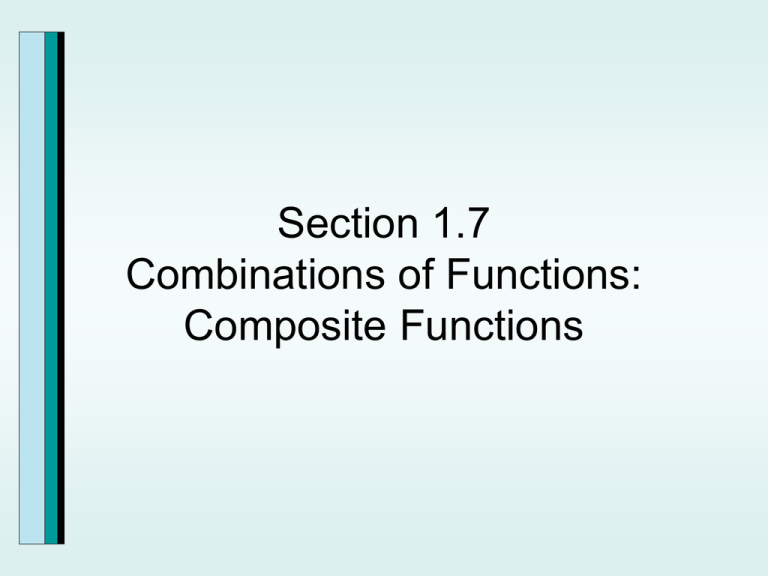Section 1.7 Combinations of Functions: Composite Functions
advertisement

Section 1.7 Combinations of Functions: Composite Functions 3x+5 x2 4x 5 x2 4x 5 0 g(x)= x 5 x 1 0 x 5 0 x 1 0 x=5 x=-1 Domain: -,-1 1,5 5, h( x ) 2 x 5 2x 5 0 2x 5 5 x 2 5 Domain : , 2 Domains of Other Functions f ( x) 4 x 5 Domain : , f ( x) x 2 7 x Domain -, f ( x) 3 x Domain : , Example Find the domain of the function 4x-1 f(x)= 3x+2 Example Find the domain of the function f(x)= 4x-1 f can be g simplified, determine the domain before simplifying. Example; If the function f(x)= x 2 4 and g(x)=x-2 f f x 2 in ; Domain of : , 2 2, g g f x 2 4 x 2 x 2 x2 x g x 2 x 2 Determining Domains When Adding or Subtracting Functions The domain of f+g is the set of all real numbers that are common to the domain of f and the domain of g. Thus we must find the domains of f and g before finding their intersection. Suppose f ( x) x+3 and g(x)= x-2 then (f+g)(x)= x+3 x 2 Now for their domains. f ( x) x+3 g(x)= x-2 x3 0 x-2 0 x 3 x2 So the domain for the sum of the functions is x 2 which in interval notation is 2, Continued on next slide The graph of (f+g)(x)= x+3 x2 confirms that the domain of this function is 2, y x Continuation of the same problem. Determining Domains when Multiplying Functions The domain of f g is the set of all real numbers that are common to the domain of f and the domain of g. Thus we must find the domains of f and g before finding their intersection. 5 3 Suppose f ( x) and g(x)= then x x-2 15 (fg)(x)= x x-2 y Now for their domains. 5 3 f ( x) g(x)= x x-2 x0 x-2 0 x2 So the domain for the product of the functions is x 0, x 2 which in interval notation is -,0 0, 2 2, Example If f(x)=5x-1 g(x)=x 2 2 x 1 Find each of the following: (f+g)(x) (f-g)(x) (fg)(x) f ( x) g Example If f(x)=5x-1 g(x)=5x 2 9 x 2 Find the domain of the following: (fg)(x) f ( x) g Example 1 1 Find the domain g(x)= If f(x)= 2x 1 x of the following: (fg)(x) f ( x) g Example If f(x)= x-1 g(x)= x-6 Find the domain for: (f-g)(x) f(g(x))=0.85x - 300 We read this equation as "f of g of x is equal to 0.85x-300." We call f(g(x)) the composition of the function f with g, or a composite function. This composite function is written f g The domain of f g is ,0 0,3 3, Example 3 2 Given f(x)= and g(x)= . x-4 x a. Find f g x b. Find the domain of f g Example 2 Given f(x)= and g(x)= x. x-3 a. Find f g x b. Find the domain of f g 22 hh(( xx)) x x 33xx 22 can can be be written written as as the the composition composition of of what what two two functions? functions? 22 g(x)= g(x)=xx ff (( xx)) 33xx 22 xx hh(( xx)) ff gg xx Example Express h(x) as a composition of two functions: h( x ) x 6 x 5 2 4 Example Express h(x) as a composition of two functions: 1 h( x ) 2 9 x 64 Find the domain of the function 3x-1 f(x)= 2 x 6x 7 (a) (b) (c) (d) , 1 1,7 7, ,1 1,7 7, , 1 7, , 1 1,7 7, 2 If f(x)=3x-1 and g(x)=x , Find (f+g)(x) (a) 3x 2 1 (b) (3 x 1) 2 (c) x 2 3x 1 (d) x 2 3x 1 Find the domain of f g x if f(x)= x-4 and g(x)=4 3 x (a) 0, (b) 3, (c) (d) , 3 ,0

